DECEMBER 2015 / JANUARY 2016
New Study Charts NYPD Enforcement Activity
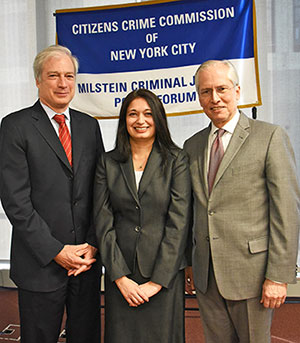 A team of John Jay researchers has documented a dramatic downturn in enforcement actions by New York City police between 2011 and 2014, after the number of arrests, summonses and stop-and-frisk actions had risen just as sharply in the previous eight years.
A team of John Jay researchers has documented a dramatic downturn in enforcement actions by New York City police between 2011 and 2014, after the number of arrests, summonses and stop-and-frisk actions had risen just as sharply in the previous eight years.
The results of a study led by Professor Preeti Chauhan and President Jeremy Travis were presented Dec. 11 at Citizens Crime Commission forum held at the College. The findings formed the basis of the report “Tracking Enforcement Rates in New York City: 2003-2014.”
Researchers found 804,750 fewer enforcement actions taken by the NYPD from 2011-2014, although the decrease was not evenly distributed across the city’s population. Just as the earlier rise in enforcement activity had been most acutely experienced by young men, particularly young black and Hispanic men, declines in enforcement activity were also more pronounced within these demographic groups.
“The rise and decline in enforcement actions in New York City over the past decade is simply stunning,” said Travis. “The sharp increase has been well documented. We are now witnessing the mirror-image decline, resulting in a significantly different level of police-public interaction, particularly for young men of color. This report will provide the empirical basis for an important discussion of the consequences of this profound shift in policing practices.”
The study charted changing patterns in felony arrests, misdemeanor arrests, criminal summonses, moving violation summonses, and stop, question and frisk activities, based on data provided by the New York State Office of Court Administration, the state Division of Criminal Justice Services, the New York City Police Department, and the U.S. Census Bureau.
Key findings include:
Enforcement activities increased considerably overall from 2003 to 2011, and decreased dramatically over the following three years. These trends were driven primarily by a substantial increase and subsequent decrease in stops, and secondarily by criminal summonses and misdemeanors.
Over the course of the study period, men, young people and racial/ethnic minorities experienced the greatest amount of fluctuation in enforcement rates. Enforcement rates for women, older age groups, and whites remained relatively constant.
There were also differences in enforcement activity within demographic groups. For example, the gender gap in enforcement rates between men and women decreased while gaps between the youngest and oldest age groups, and between racial/ethnic groups, fluctuated much more, resembling the overall trends in enforcement activity.
Click here to access the complete data analyses and report.
Funded by the Laura and John Arnold Foundation, the report is the third prepared and published by the Misdemeanor Justice Project, a John Jay research initiative headed by Chauhan that includes faculty, graduate students and staff. The first two reports — “Trends in Misdemeanor Arrests in New York” and “The Summons Report: Trends in the Issuance and Disposition of Summonses in New York City” — were released in October 2014 and April 2015, respectively.
First-Year Students, First-Rate Researchers
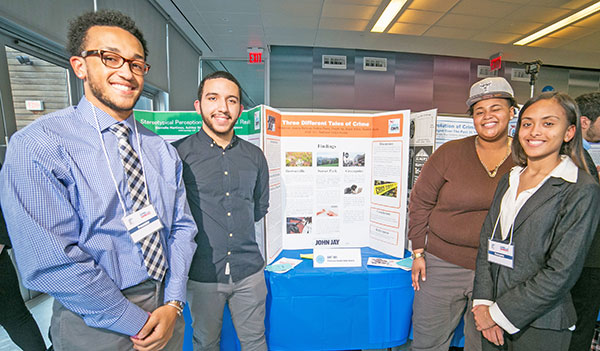
Scores of John Jay freshmen and transfer students stood proudly alongside poster presentations and other research efforts in the new building cafeteria on Dec. 10, showing off their projects as part of the annual FYE (First Year Experience) Student Showcase.
“It really is amazing that first-year students are doing such original research,” said Kate Szur, Senior Director of Student Academic Success Programs. Entering freshmen at John Jay, who can choose from dozens of Learning Communities or First-Year Seminars, presented their research at the showcase.
Transfer students also had a prominent place among the displays, joined this year by students from the APPLE Corps (Academic Preparation Program for Law Enforcement); Early Start (for pre-freshmen); Adelante! (academic success program for Latina/o students); SEEK (Search for Education, Elevation and Knowledge); OSS (Opportunity for Student Success); ACE (Accelerate, Complete, Engage), and Justice First-Year Seminars.
The First-Year Seminars are part of John Jay’s General Education curriculum. The students in each Learning Community are taught by two or more professors from different disciplines. In many cases, students work together as teams on research and other presentations, grouped either by their own choice or at the suggestion of their professors.
The presentations — 127 poster displays and 15 digital or multimedia presentations — covered a broad array of topics ranging from gender issues to police practices, from immigration to education issues affecting college students.
One quartet of students — Melanie Mirano, Kristain Sukhnandan, Kayla Sanes and Claudia Michalak — from Professor Jason Frydman’s Psychology 141 class addressed the question of whether handwriting or electronic note-taking is more effective for students. “I was surprised with the findings,” said Sanes, a Forensic Psychology major, who noted that students were more than 50 percent better at retaining information when their notes were kept electronically rather than handwritten.
Angelica Klivan, Iris LaTorre, Carmen Rosa and Cristian Yepes created a practical experiment in the gymnasium for their project “Mathematics Improves Basketball.” Three basketball players took a succession of foul shots using several arm angles and positions, as the freshman researchers recorded their accuracy. “It makes it easier to do math if you can relate it to something you’re interested in,” said LaTorre, a Political Science major.
A team of students in the APPLE Corps program got an early introduction to field research for their project “Three Different Tales of Crime, Three Neighborhoods, One Borough.” Under the guidance of Professor Ric Curtis of the Anthropology Department, joined by Professors Yolanda Martin of Borough of Manhattan Community College, Camila Gelpi-Acosta of LaGuardia Community College and Crystal Rodriguez of Bronx Community College, the six students fanned out to the Brownsville, Sunset Park and Greenpoint sections of Brooklyn to knock on doors, conduct interviews and administer surveys.
“I never thought we’d be doing hands-on research as freshmen, going out and talking to people in the field,” said Megil Patterson. One fellow researcher, Jashua Perez, said the team found that “the types of crime haven’t changed, but the rates have decreased.” Referring to the Greenpoint findings, Patterson added: “Crime went down due to technology. Criminals have gotten more sophisticated.”
Natifah Haythe, who like Patterson and Perez is a Criminal Justice major, said she was assigned to the research team, “but looking back I wouldn’t have had it any other way.”
‘Black Lives Matter’ Named as 2015’s Top Justice News Story

The "Black Lives Matter" movement, with its focus on issues of police brutality, was the dominant criminal justice news story of 2015, according to the fifth annual reader survey conducted by John Jay's Center on Media, Crime and Justice (CMCJ). Results of the survey were published Dec. 9 in The Crime Report, an online publication of the center.
Black Lives Matter launched as a hashtag and was a bold way to protest racial injustice and raise public awareness after the 2013 acquittal of George Zimmerman in the shooting death of black teen Trayvon Martin in Florida. The movement gathered momentum following events in Ferguson, Mo., and Staten Island, N.Y., last year, emerging as both a powerful voice for young Americans of all ethnic and racial backgrounds and a potent organizing platform for a new national conversation on race, policing and the justice system. Said one TCR reader:
“Black Lives Matter brought national attention to issues of police brutality in the U.S. and they have continued to fight to keep this subject in the spotlight.”
The Crime Report noted that the movement has fueled what some are calling the Second Civil Rights Movement. “In choosing the growing political profile of Black Lives Matter and related organizations as the major development of 2015, readers also appeared to signal their faith and optimism in the ability of American civil society to drive change,” said Stephen Handelman, the CMCJ’s Director and editor of The Crime Report.
In a related development, TCR readers singled out HBO talk-show host John Oliver as the 2015 criminal justice Person of the Year, in recognition of his “probing, acerbic” programs on correctional reform, prisoner reentry and other justice issues. Handelman said Oliver’s “Last Week Tonight” programs “have not only galvanized millions of viewers; they appear to have significantly improved the climate for reform.”
Click here to read TCR’s Person of the Year story.
The rest of the Top 10 criminal justice news developments this past year included:
2) Policing Goes Viral: The growing presence of body-worn cameras, patrol car dashboard cams and cellphone cams is transforming America’s relationship with law enforcement, TCR readers opined.
3) Sentencing Reform: The Senate Judiciary Committee’s decision to move the Sentencing Reform and Corrections Act to the Senate floor was described by one TCR reader as a development that represents “the single issue on which the left and right have been able to come together.”
4) Jails in the Spotlight: Fueled by recent events, discussions about corrections reform have begun to focus on reducing the use of jail and raising awareness of the overcrowding that afflicts detention facilities, “a long-neglected corner of justice.”
5) The Charleston Massacre: The June 17 murder of nine people in a historic black church in Charleston, S.C., by a young white man spouting white supremacist views added to concerns about “lone wolf” domestic terrorism in the U.S.
6) Presidential Pulpit: President Obama uses the White House’s “bully pulpit” to address high profile criminal justice issues ranging from policing to prison reform.
7) Right & Left Together: TCR readers pointed to a “love-fest” between liberals and conservatives that is likely to have an impact on the national conversation on justice reforms and the justice debate in 2016.
8) Heroin in the Heartland: The rise in heroin addiction is seen as rekindling a long-overdue debate about whether to shift the country’s “war on drugs” from a focus on punishment to providing better tools for treating addiction as a health epidemic.
9) Rethinking the Death Penalty: TCR readers said the debate over capital punishment reached a potentially decisive moment during 2015, with the constitutionality of the death penalty possibly headed back to the U.S. Supreme Court.
10) A New Crime Wave: Homicide totals rose during 2015 in Baltimore, New Orleans and a half dozen or more other major cities, prompting questions about whether the nation’s crime decline is over, and whether policing’s loss of aggressiveness in the face of criticism is a contributing factor.
Click here to read The Crime Report article.
Students Shine at Biomedical Research Conference
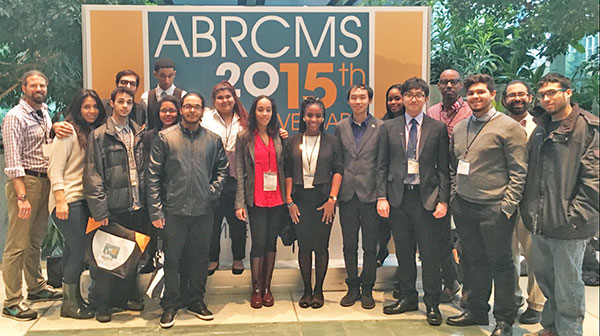
Fifteen future scientists, all part of John Jay’s Program for Research Initiatives in Science and Math (PRISM), presented their research at the 15th Annual Biomedical Research Conference for Minority Students (ABRCMS) held in Seattle in November. Three of them —William Aguilar, Ronald Rodriguez and Jiwon Seo — won awards for their oral and poster presentations on the research they are conducting under the mentorship of John Jay faculty.
More than 1,700 undergraduate and graduate students from around the country participated in presentations in 12 disciplines in the biomedical and behavioral sciences. ABRCMS, one of the largest professional conferences in United States, is designed to encourage underrepresented minority students to pursue advanced training in science, technology, engineering and mathematics and provide faculty mentors and advisors with the resources to facilitate students’ success.
Dr. Edgardo Sanabria-Valentin, PRISM’s Program and Research Coordinator, accompanied the John Jay undergraduate students to Seattle, along with Professors Nathan Lents and Jason Rauceo. Nine of the 15 students received travel awards from the conference organizers and three of them secured a coveted spot among the 96 oral presentations in the conference.
The 2015 ABRCMS attendees, their faculty mentors and their research projects are:
William Aguilar (Professor Elise Champeil) — Correlation of Mc and Dmc-Adducts Structures with the Role of P21 in the Toxicity of the α-icl and β-ic. (Winner, Chemistry Oral Presentation Award.)
Imani Hargett (Professor Lissette Delgado-Cruzata) — Understanding the Role of TET Proteins in 5-Hydroxymethylation in Hepatocellular Carcinoma.
Erica Klafehn (Professor Angelique Corthals) – 2D to 3D Rending of Bones Samples from Sus scrofa.
Daysi Proano (Professor Jason Rauceo) — Characterizing MHCI Cytoplasmic Domain Phosphorylation in vitro and Its Role in Binding Interactions.
David Rodriguez (Professor Artem Domashevskiy) — Synthesis of Fluorescently-Labeled Tobacco Etch Virus (TEV) RNA and its Interactions with Pokeweed Antiviral Protein (PAP).
Ronald Rodriguez (Rauceo) — Localization Analysis of a Major Osmotic Stress Response Gene in the Fungus Candida albicans. (Winner, Microbiology Oral Presentation Award.)
Danielle Rouse (Professor Anthony Carpi) — The Reduction Mechanism of Mercuric Oxide in the Environment.
Jiwon Seo (Professor Shu-Yuan Cheng) — The Effects of Upstream Nucleotides on the Readthrough Rate of VEGF-Ax. (Winner, Biochemistry Poster Presentation Award.)
Shanelle Shillingford (Professor Gloria Proni) — The Oxidation of Allylic Alcohols to Ketones with the Use of Electrochemistry.
Donovan Trinidad (Professor Nathan Lents) — Analysis of the Human Microbiome on Living and Decomposing Bodies.
Sabrina De Los Santos (Professor Artem Domashevskiy) – Analysis of the Effects of Turnip Mosaic Virus Protein-Linked Genome on Ricin a Chain Depurination of Eukaryotic Ribosomal RNA
Yuanzhuo “Jove” Zhang (Professor Guoqi Zhang) – Diverse Copper(ii) Complexes with Simple Nitrogen Ligands: Structural Characterization and Applications in Aerobic Alcohol Oxidations in Water
Ronal Peralta (Professor Anthony Carpi) – Using Moss as a Biomonitor to Detect Atmospheric Sources of Mercury
Lisset Duran (Professor Lissette Delgado-Cruzata) – Studying the Loss of DNA Methyltransferase DNMT1 in BRCA1 Expression in Breast Cancer
Porfirio Fernandez (Professor Jason Rauceo) – Behavior Expression Profile of alpha-Conotoxin PeI A in Chronic Constriction Injury Model in Rats
Professor Brotherton Honored at Annual Criminology Conference
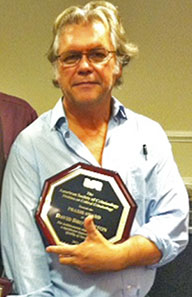 The 71st annual American Society of Criminology conference, held Nov. 18-21 in Washington, D.C., was once again a tour de force for John Jay, with scores of faculty, staff and students presenting papers and posters, and participating in panel discussions and roundtables.
The 71st annual American Society of Criminology conference, held Nov. 18-21 in Washington, D.C., was once again a tour de force for John Jay, with scores of faculty, staff and students presenting papers and posters, and participating in panel discussions and roundtables.
Professor David Brotherton provided one of the conference highlights for John Jay when he received the DCC Praxis Award from the ASC’s Division of Critical Criminology. The award, now in just its second year, honors unique achievements in activism, commitment, persuasion, scholarship, service and teaching in areas that have made a significant impact on the quality of justice for underserved, underrepresented, and otherwise marginalized populations.
Faculty members were well represented in the ASC’s “Author Meets Critics” sessions. Presenting authors included Brotherton (Youth Street Gangs: A Critical Appraisal), and his Sociology Department colleague Barry Spunt (Heroin and Music in New York City). The critics in these sessions included Professors Rosemary Barberet and Jayne Mooney of the sociology department, Mangai Natarajan and Michael Maxfield of the Department of Criminal Justice, and Klaus von Lampe and Delores Jones-Brown of the Department of Law, Police Science and Criminal Justice Administration.
President Jeremy Travis chaired a Presidential Plenary session on “The Politics of Policing American Cities,” and participated in a panel on the 50th anniversary of the U.S. Crime Commission, its legacy and whether a new one is needed.
John Jay hosted a reception on Nov. 20 for members of the College community at the ASC conference and alumni in the Capital area.
Police Explorer Student Earns National Honors

Police Explorer Samson Hung (r.)
with Suffolk County Legislator Kevin McCaffrey.]
Samson Hung is only 19, but he has already earned a national career achievement award — for his work in the Police Explorers program in Suffolk County.
Hung, a sophomore Police Studies major and a squad sergeant with the First Precinct Explorer program, was honored by the Suffolk County Police on Oct. 23 at the Police Academy in Brentwood. He is the only second Explorer in the organization’s history to receive the prestigious award. “Getting this award was very challenging, and it’s nice to be recognized for the years of work that I’ve put in,” said Hung.
The Explorers Program provides 14- to 20-year-olds with professional skills and techniques to help them succeed in life and as a police officer. Hung says he saw the Explorers as a great opportunity to get a head start on his hoped-for law enforcement career.
“I started right when I turned 14,” said Hung, a resident of Wheatley Heights, “and over the years, I’ve enjoyed learning about law enforcement and being able to give back to my community.” The program, he said, helped shape his decision to attend John Jay. “I wanted to be a part of the John Jay community not only because of the College’s preeminent reputation worldwide for criminal justice, but also because I wanted to learn from distinguished professors and meet other students who have a similar goal.”
Officer Margery Marotta, the program adviser, praised Hung, noting that since he joined the Explorers program he has “worked incredibly hard to achieve his dream, even taking additional language classes on the side to learn Mandarin in the hopes of someday serving the Chinese-American community. I can’t see anyone doing better than him.”
To receive the career achievement award, Hung had to complete more than 500 hours of training and service and earn several proficiency awards including a community service award for 100 hours of service and the 2014 Explorer of the Year honor.
“I feel proud and honored because all the challenges I've faced were overcome by hard work and perseverance,” he said. “I am grateful to my mentors, friends, family and the Police Department for their love and support throughout my journey.”
Homecoming Is Quite the Event for Returning Alumni
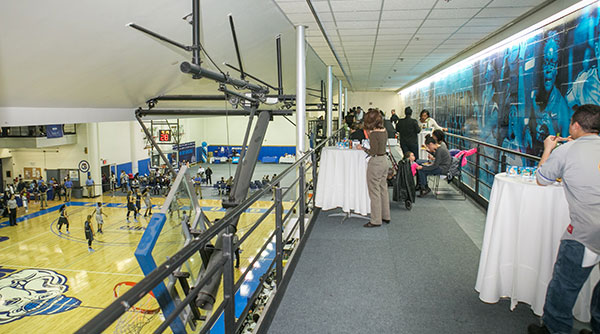
Dozens of alumni and friends of John Jay athletics were on hand on Dec. 10 for the annual Homecoming Day festivities. Guests watched both the women’s and men’s basketball games from the exclusive Alumni Sky Box above the gymnasium. The first 50 alumni in attendance received special John Jay Bloodhound swag, and all dined on a catered menu provided by Dinosaur BBQ, which has become a standing tradition and fan favorite in the Sky Box over the past three years.
Vintage athletics apparel and other John Jay-branded gear were on sale throughout the evening. A salute to graduating senior student-athletes was held in between games, and one lucky fan got to take a shot from half court that, if successful, would have been worth $10,000.
Sadly, the Bloodhound teams failed to provide icing on the cake, as the women’s team was soundly defeated by the College of Staten Island, 78-43, while the men’s team fell by a score of 81-65.
J Journal Scores Again in Pushcart Prize Literary Rankings
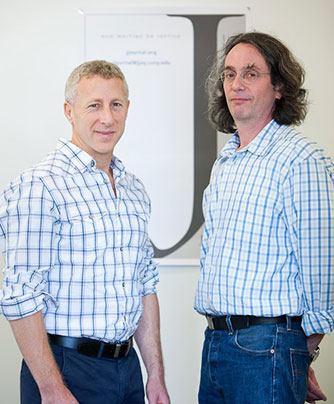
The J Journal: New Writing on Justice – John Jay’s literary journal founded and co-edited by English Professors Adam Berlin and Jeffrey Heiman – has been ranked 52nd out of 245 publications featured in the 2016 Pushcart Prize Literary Magazine Rankings for Fiction, placing it ahead of several notable and longstanding journals.
Published twice a year, J Journal targets readers of literary journals and criminal justice professionals interested in creative writing. Contributors to the journal include new and established writers, lawyers, police officers, prison inmates, and academicians. The journal was also recognized in 2013 with the Pushcart Prize for Fiction, and received two Special Mentions in the 2011 Pushcart Anthology.
The latest issue of the J Journal is now available. For subscription information and submission guidelines, please visit www.jjournal.org or email jjournal@jjay.cuny.edu.
Faculty/Staff Notes
On Board
Keri Reitman (Marketing and Development) is John Jay’s new Director of Special Events. Reitman, whose first day at John Jay will be Jan. 5, has more than 20 years of special events experience with such institutions as the Greenwich Historical Society, Pace Law School, the Big Apple Circus and the Alliance for Lupus Research.
The Printed Page
Peggilee Wupperman’s (Psychology) article “Understanding Self-Destructive (Dysregulated) Behaviors” was published Dec. 6 in the online edition of Psychology Today. Click here to read the article.
Recognition
Jessica Gordon Nembhard (Africana Studies) has been named as one of the 2016 inductees to the Cooperative Hall of Fame. Nembhard, who is Economic Development Director for the McNair Post-Baccalaureate Achievement Program at John Jay, is the author of Collective Courage: A History of African American Cooperative Economic Thought and Practice. Her induction ceremony will take place next May.
Susan Opotow (Sociology) has been elected to a three-year term on the American Psychological Association’s Board for the Advancement of Psychology in the Public Interest. She is a past president of the APA Division 9, the Society for the Psychological Study of Social Issues.
